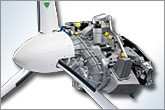Tue, May 11, 2010
Life Extension To 1,500 Hours Certified
 Centurion is launching a 'service
offensive' for the kerosene piston aircraft engines in its
Centurion 2.0 series. The operational lifetime for this engine has
been extended to 1,500 hours. Centurion has also arranged to bypass
the 1,200 hour factory inspection. What that means for the owner is
that the engines no longer have to be removed at 1,200 hours and
sent back to the factory in Lichtenstein, Germany, it can now
be conducted at all authorized Centurion service centers. The move
will result in a significant reduction in the maintenance costs and
AOG times of the aircraft, but Centurion is now looking to extend
the operational lifetime to 1,800 hours for the Centurion 2.0.
Centurion is launching a 'service
offensive' for the kerosene piston aircraft engines in its
Centurion 2.0 series. The operational lifetime for this engine has
been extended to 1,500 hours. Centurion has also arranged to bypass
the 1,200 hour factory inspection. What that means for the owner is
that the engines no longer have to be removed at 1,200 hours and
sent back to the factory in Lichtenstein, Germany, it can now
be conducted at all authorized Centurion service centers. The move
will result in a significant reduction in the maintenance costs and
AOG times of the aircraft, but Centurion is now looking to extend
the operational lifetime to 1,800 hours for the Centurion 2.0.
"Our Lifetime Extension Program is now taking full effect. First
the fuel feed pump, which is already at 1,200 hours; and now 1,500
hours for the engine and - most important - no factory inspection
any longer," said Centurion CEO Jasper M. Wolffson. "For customers,
this means a cost reduction in 1,200 hour service by over 7,000
Euros ($9000). Our fleet customers in particular are delighted with
this progress."
 The 1,200 hour maintenance interval
more or less corresponds to 600-hour maintenance. In addition, it
is also necessary to replace the V-ribbed belt, the oil thermostat
screw plug, a number of hoses (depending on the aircraft type) and
the coolant. The engine, however, no longer has to be removed and
sent back to the production organization for inspection, as would
have been necessary with the originally-planned factory inspection.
This cuts out the cost of removing and refitting the engine along
with the associated transport costs. The average labor time
decreases on average from 14 down to around one hour, which means a
significant reduction of the aircraft on ground (AOG) time.
The 1,200 hour maintenance interval
more or less corresponds to 600-hour maintenance. In addition, it
is also necessary to replace the V-ribbed belt, the oil thermostat
screw plug, a number of hoses (depending on the aircraft type) and
the coolant. The engine, however, no longer has to be removed and
sent back to the production organization for inspection, as would
have been necessary with the originally-planned factory inspection.
This cuts out the cost of removing and refitting the engine along
with the associated transport costs. The average labor time
decreases on average from 14 down to around one hour, which means a
significant reduction of the aircraft on ground (AOG) time.
With some 300 plus service centers, one of the largest service
networks in General Aviation is available for Centurion engines
with service centers on all continents. Centurion says over 2,600
of its engines are operating in various aircraft types, and have
racked up more than 2 million flight hours.
More News
He Attempted To Restart The Engine Three Times. On The Third Restart Attempt, He Noticed That Flames Were Coming Out From The Right Wing Near The Fuel Cap Analysis: The pilot repor>[...]
Make Sure You NEVER Miss A New Story From Aero-News Network Do you ever feel like you never see posts from a certain person or page on Facebook or Instagram? Here’s how you c>[...]
From 2009 (YouTube Edition): Leading Air Show Performers Give Their Best Advice for Newcomers On December 6th through December 9th, the Paris Las Vegas Hotel hosted over 1,500 air >[...]
Aero Linx: NASA ASRS ASRS captures confidential reports, analyzes the resulting aviation safety data, and disseminates vital information to the aviation community. The ASRS is an i>[...]
“For our inaugural Pylon Racing Seminar in Roswell, we were thrilled to certify 60 pilots across our six closed-course pylon race classes. Not only did this year’s PRS >[...]
 NTSB Final Report: Rutan Long-EZ
NTSB Final Report: Rutan Long-EZ ANN FAQ: Turn On Post Notifications
ANN FAQ: Turn On Post Notifications Classic Aero-TV: ICAS Perspectives - Advice for New Air Show Performers
Classic Aero-TV: ICAS Perspectives - Advice for New Air Show Performers ANN's Daily Aero-Linx (06.28.25)
ANN's Daily Aero-Linx (06.28.25) Aero-News: Quote of the Day (06.28.25)
Aero-News: Quote of the Day (06.28.25)




